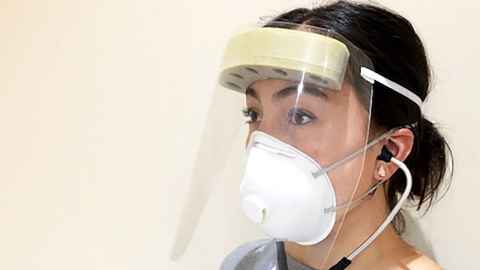Using creative design and 3D printing to make the world a safer place
15 April 2020
Engineers in the Creative Design and Additive Manufacturing Laboratory (the Lab) at the Faculty of Engineering, University of Auckland, have designed a simple emergency ventilator operated by an automated hand.

It is one of a number of designs developed in response to Covid-19 by a team led by Professor Olaf Diegel, a multi-award-winning product design developer who took up his role as head of the Lab last year, where he aims to change the way Additive Manufacturing (AM, otherwise known as 3D printing) is used across many industries.
He and his team have in the last few weeks developed myriad prototype designs to keep people safer during the Covid-19 epidemic.
This includes the prototype ventilators. These are not intended to replace high-end ventilators, but to replace manual ventilators (known as an Ambu-bag or Bag Valve Mask). The prototype design includes an automated hand. It also allows for the adjustment of some ventilator functions including breaths per minute, pressure and volume.
Ventilators constitute a Class II medical device, so their prototype will still need to go through clinical trials before getting approval from the FDA or equivalent regulatory body before being used.
As the Lab at the University is currently in lockdown and the team unable to physically test their design, they have made it open-source to all so that others working in this area can print it, test it and improve on it.
This crisis is occurring on a completely global scale, and even with border closures, whatever happens in one country affects all the others ... it is imperative that we all work as a community on trying to solve the problem globally.
“As soon as we are able to build and test our own we will, no doubt, be improving it, and will make all the new files open source too,” says Dr Diegel.
While their ventilators are unlikely to be needed in New Zealand, they will be of great use for countries that don’t have or can’t afford enough high-end ventilators.
“At best, this type of ventilator could only be used as a controlled mechanical ventilation system (CMV). It doesn’t allow any synchronisation with the patient’s own breathing and is only for when patients are deeply unconscious and paralysed.
“But it could be used for patients needing to be transported from one place to another, and to free up the hands of the medical person that might, otherwise, have to manually ventilate the patient with an Ambu-bag.”
He and his team have been busy on a number of personal protective equipment (PPE) projects aimed at improving the safety of people in the time of the COVID-19 pandemic, particularly healthcare workers.
With Associate Professor Don Clucas, of Canterbury University, they have been working on a low-cost disposable face shield which takes around 30 seconds of laser cutting and 30 seconds of assembly. They have also designed a reusable 3D printable face shield that can also be sterilised, and is foldable “so a heap of them can be printed as a single batch in a powder bed fusion machine,” says Dr Diegel.
“The prototypes were printed by colleagues at Lund University in Sweden. On my little baby machine at the University I could do a 108 sets of these in an overnight batch, which is not close to mass production, but maybe enough to help in an emergency.”
Although there are much better ways of making face shields for mass-production, such as injection molding, the main problem in many countries is less about the manufacturing and more about the distribution of PPE to get it the hands of the people who need it.
“This is why 3D printing and laser cutting have proved so useful, all over the world, in allowing localised distributed manufacturing where products are made, and where and, they a when they are needed, instead of being shipped around the country or world.”
They have also designed a simple hands-free door opener, and a foot-operated operated door opener, which avoid the contamination from door handles.
All these designs have been made open-source, to be shared among companies and people working in the area of PPE design.
“The Covid pandemic has opened up a whole new way of doing design for the greater good,” says Dr Diegel. “This crisis is occurring on a completely global scale, and even with border closures, whatever happens in one country affects all the others.
“As we are all in this together, it is imperative that we all work as a community on trying to solve the problem globally. This is why we are making all our design open-source so that others can improve them or adapt them to suit their particular circumstances and manufacturing capabilities.”

Media contact
Margo White I Media adviser
DDI 09 923 5504
Mob 021 926 408
Email margo.white@auckland.ac.nz